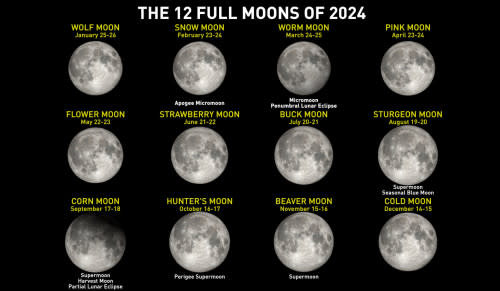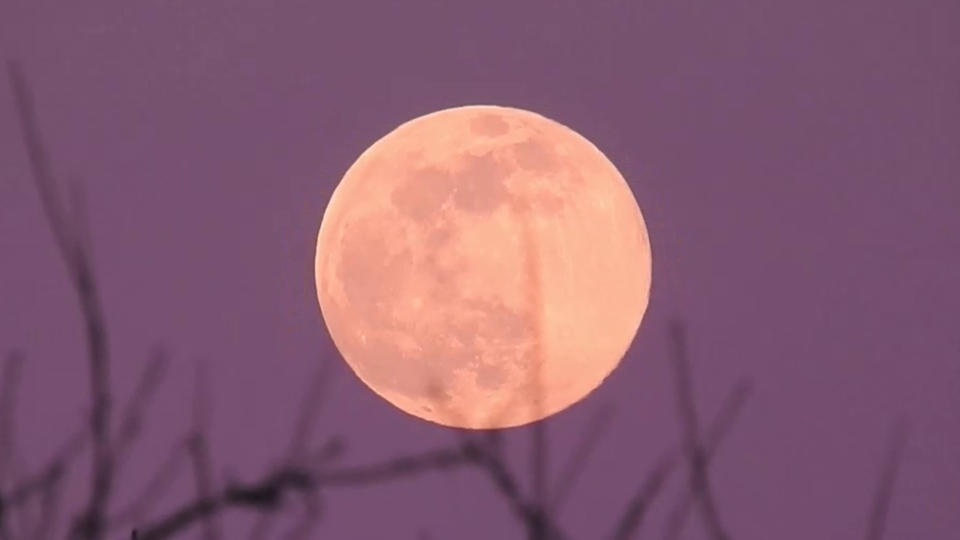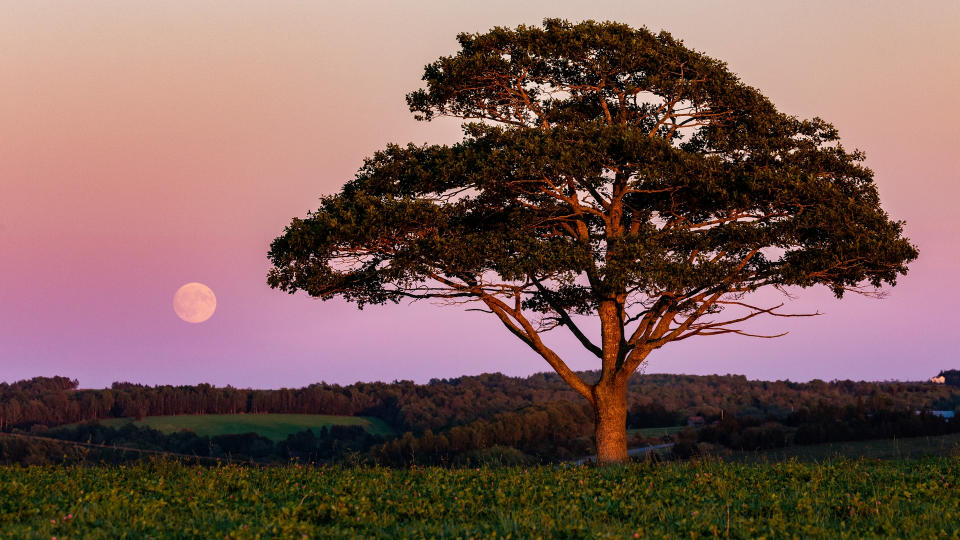Look up tonight for the Full Pink Moon

At exactly 7:49 p.m. EDT on Tuesday night, the Moon will be on the exact opposite side of Earth from the Sun, marking the moment of April's Full Moon.
However, according to NASA, observers will note that the Moon appears full for roughly 3 days time, from Monday morning through Thursday morning. This is simply due to it being so close (around 99 per cent or more) to fully illuminated that, to the casual observer, it is difficult to notice the extremely thin dark crescent along one side of the Moon or the other.
Focus on the Moon's face a bit longer on Monday night and Wednesday night, though. You may note that one side looks "fuzzy" compared to the crisp edge on the other side, revealing that the Moon is actually in its Gibbous phase at that time. Binoculars or a telescope will make this even easier to spot.
Visit our Complete Guide to Spring 2024 for an in-depth look at the Spring Forecast, tips for the season, and much more!
What is a Pink Moon?
Each Full Moon of the year goes by various names, first written down for the Farmer's Almanac close to a century ago. The popular name of the April Full Moon is the Pink Moon.

This graphic collects all the relevant data about each Full Moon of 2024, including their popular names, whether they are a 'super' or 'micro' Moon, a perigee or apogee Full Moon, and whether they are remarkable in some other way, such as a Blue Moon, Harvest Moon or a lunar eclipse. Credit: NASA's Scientific Visualization Studio/Scott Sutherland
These names were inspired by Colonial and European folklore, as well as the lunar calendars of First Nations peoples living in the US Northeast.
The Pink Moon isn't named for the Moon's colour, though. Instead, The Old Farmer's Almanac says this Full Moon gets its name from wild ground phlox. Also known as pink moss, this is one of the first wildflowers that bloom in the US Northeast during the spring.
They also list several other names used by indigenous people for the April Full Moon, including Breaking Ice Moon (Algonquin), Broken Snowshoe Moon (Anishinaabe), Budding Moon of Plants and Shrubs (Tlingit), Frog Moon (Cree), Moon of the Red Grass Appearing (Oglala), Moon When the Ducks Come Back (Lakota), Moon When the Geese Lay Eggs (Dakota), Moon When the Streams are Again Navigable (Dakota), Sucker Moon (Anishinaabe), and Sugar Maker Moon (Western Abenaki).
It's important to note these names are not only for the Full Moon alone. Like many advanced cultures around the world, First Nations people tracked the year using a lunar calendar. The name for each moon actually refers to the 'lunation' — the roughly 29-day period between that Full Moon and the next. Thus, these names are equivalent to the names of the months in the modern Gregorian calendar.
DON'T MISS: Bright planets and meteor showers are visible throughout Spring 2024
Additionally, this is the Passover or Pesach Moon in the Hebrew calendar, with Passover beginning at sunset on Monday, April 22.
For many Hindus, this Full Moon marks the Hanuman Jayanti festival, which celebrates of the birth of the Hindu deity Hanuman, who is revered as a symbol of strength.
Also, in Sri Lanka, Buddhists celebrate Bak Poya (or Bak Pura Pasaloswaka Poya Day) on this night. This celebration commemorates the Buddha's second visit and the peace that he brought to the island by settling a dispute that threatened to cause a war between two feuding factions of the community.
Will the Moon turn pink?
Regardless of its popular name, when you gaze up at the Moon Tuesday night, it most likely will not be pink.
However, if the weather conditions are just right as Full Moon is rising, there is a chance.

This pink-tinged Full Moon was captured from Eskasoni, Nova Scotia on April 7, 2020. Credit: Riki Christmas/UGC
This is due to a phenomenon known as the Belt of Venus.
The Belt of Venus can appear on any night of the year, usually occurring during clear, calm weather. It shows up as a band of pink sky stretched along the eastern horizon just after the Sun has set in the west. This colour is caused by tiny particles in the air — dust, pollen, etc. — scattering back the colours of the sunset.
As the evening progresses, the pink hue often becomes separated from the horizon by a dark blue-grey band, as Earth's shadow is cast upon the same particles in the atmosphere.

The Harvest Moon rose through a Belt of Venus on the night of September 23, 2018, as seen from Shubenacadie, NS. Credit: Barry Burgess/UGC
However, later in the night, when the Moon is higher in the sky, it will appear in the same shades of grey it usually does.
For early-risers, the Belt of Venus can also appear in the pre-dawn sky, under the same calm weather conditions. Thus, there's a chance of catching this Full Moon turning pink just before it sets Wednesday morning.
Read More: What is the mysterious Moon Illusion?
Thumbnail image and video courtesy Riki Christmas, who captured a rare pink Full Pink Moon from Eskasoni, Nova Scotia, on April 7, 2020, and posted them in The Weather Network's UGC gallery.
